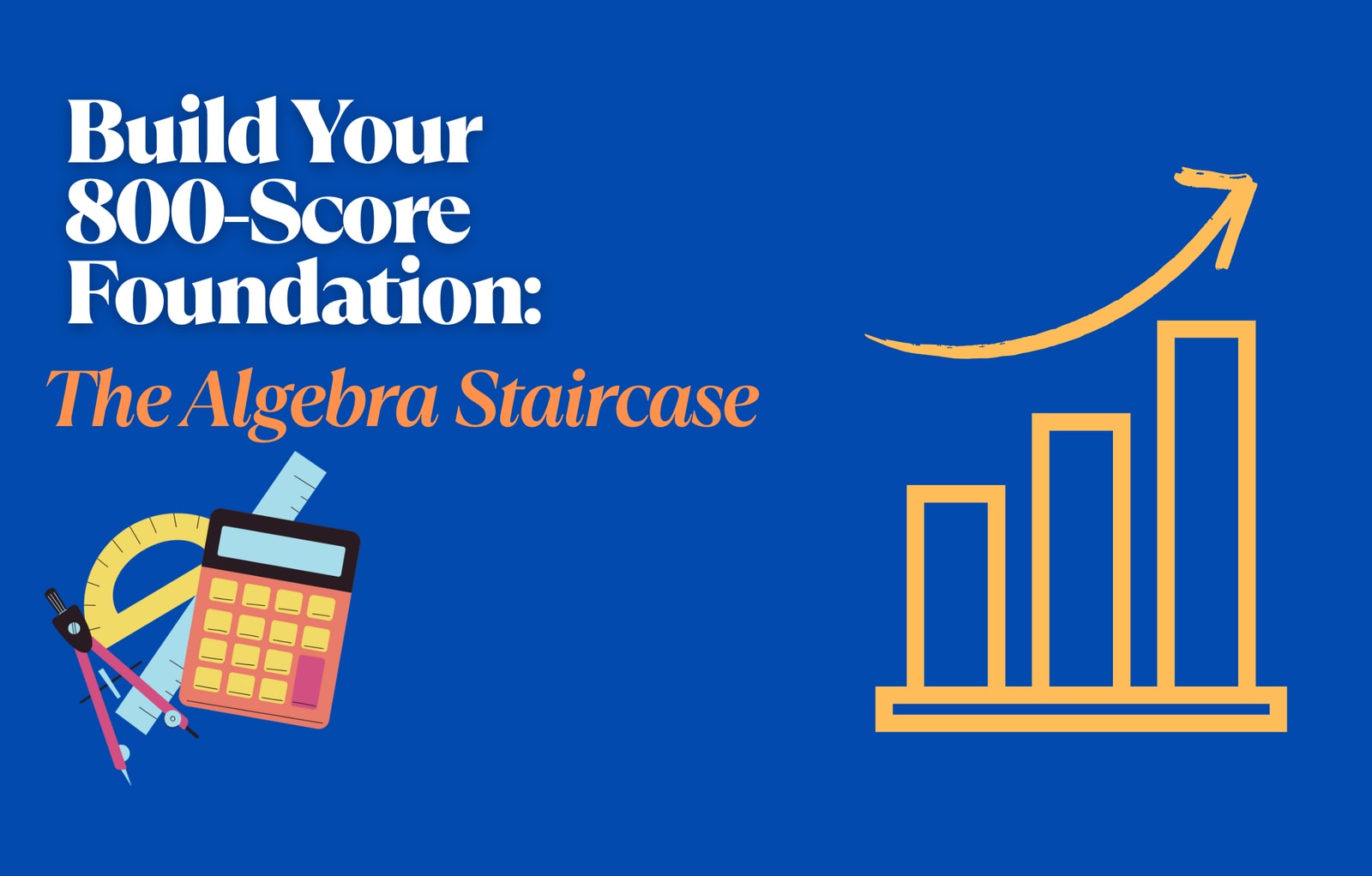Construct Your DSAT Math Success: The Algebra Staircase
Author
Phoenix Wilder
Date Published

Imagine standing at the base of a staircase—a staircase that ultimately leads not just to a higher test score, but to stronger problem-solving, sharper logic, and confidence in every math challenge you face. The very first, and in many ways the most fundamental, part of this staircase is Algebra. On the DSAT, algebra is more than just a subject area; it is the thread weaving through nearly every math question, the step under every other step. Climb with me, as we explore how mastering algebra can empower every rung of your mathematical ascent.
Step 1: Understanding the Power of Variables
At the heart of algebra lies the variable—that mysterious letter, often x or y, representing the unknown. Learning to work with variables is like getting a master key for all sorts of mathematical doors. You’ll see variables in simple equations such as
2x + 7 = 15
and in more complex expressions peppered through the DSAT.
Algebra trains you to ask: "What is unknown? What do I know? How do I get from what I know to what I need?" This thinking is crucial not only for the test, but for real problem-solving in everyday life.
Tips:
· Always isolate the variable step by step.
· Check your solution by plugging it back into the original equation.
Step 2: The Language of Equations and Expressions
Algebra is a language—a way of translating real-life situations (“If I buy 5 apples and each costs $2…”) into mathematical sentences. In DSAT math, you’ll often be asked to construct or interpret equations from word problems.
For example, “John has twice as many pencils as Sarah. Together they have 15 pencils.” This translates to:
x + 2x = 15, where x is the number of Sarah’s pencils.
This skill—moving seamlessly between words and math—is at the core of DSAT, and strong algebra helps you decode any scenario quickly.
Tips:
· underline keywords in problems ("twice," "more than," "total") to help set up equations correctly
· define variables clearly at the start of each problem
Step 3: From One Equation to Two—Systems of Equations
Moving higher, you’ll encounter problems where two unknowns are related—a classic area of DSAT algebra. Systems of equations are like two interlocking puzzles:
x + y = 10
x - y = 2
Here, Algebra equips you with methods such as substitution and elimination to find the exact values of x and y. Systems appear everywhere: splitting costs, comparing speeds, mixing solutions.
Mastery of this step gives you a big advantage, as these are often multistep, higher-value questions on the DSAT.
Tips:
· stack equations vertically to spot patterns
· check solutions in both equations to avoid small mistakes
Step 4: Equations on the Move—Graphing Lines
Climb further, and algebra starts to take shape visually. The DSAT often tests how well you can move between an equation
(y = mx + b)
and its graph on the coordinate plane. Understanding slope (m) and y-intercept (b) is like reading a map—you can instantly see how a change in one variable affects another.
Algebra helps you analyze:
where two lines cross (their solution)
what happens if the slope increases or the line shifts up/down
Graphing isn’t just about drawing—it’s about predicting and verifying relationships between numbers.
Tips:
· practice matching equations to graphs and vice versa
· memorize the effects: slope changes angle, y-intercept moves the line up or down
Step 5: Quadratics and Expressions Beyond the Line
Algebra doesn’t stop with straight lines. DSAT algebra involves
quadratic equations (like x² + 6x + 5 = 0)
and the skill to factor or use the quadratic formula. These abundant “U-shaped” relationships show up in projectile motion, area problems, and more.
Learning to:
· recognize a quadratic
· factor it (when possible)
· or apply the quadratic formula
gives you access to yet another class of DSAT questions.
On this step, algebra is about flexibility. Sometimes a complicated problem simplifies when you rewrite or restructure the equation.
Tips:
· master factoring, as it often yields a quick win
· memorize the quadratic formula and practice applying it steadily
Step 6: Algebra in Modeling and Real-World Scenarios
Above all, DSAT wants you to use algebra as a tool for reasoning in real-world contexts:
· figuring out pricing and discounts
· solving problems about mixtures or investments
· analyzing growth or decay (exponential models)
You’ll set up equations to model situations, solve for an unknown, and interpret your solution’s meaning. The ability to translate a scenario to an algebraic model is often what separates a good score from a great one.
Tips:
· draw diagrams or write out steps for complex word problems
· double-check if your answer makes sense in the real scenario (“Can you have -3 books?”)
Step 7: Algebra’s Role in Advanced Topics
Even when you climb into geometry, trigonometry, and statistics, algebra is never left behind. Most DSAT geometry problems, for example, require setting up an equation to solve for a missing side, angle, or area. Probability and statistics on the DSAT often boil down to organizing relationships algebraically.
Tips:
· don’t compartmentalize: always look for how algebra can simplify or clarify a problem
· translate unfamiliar contexts into equations before calculating
Climbing the Staircase: Strategies for Success
· Practice regularly and with variety. The more types of algebraic problems you solve, the more "stair steps" you add to your ladder.
· Review your mistakes. Understanding why an error happened is crucial for improvement.
· Build a formula sheet. Core algebra formulas (linear, quadratic, factoring rules) should become second nature.
· Simulate real DSAT conditions. Work with time limits and mix up problem types.
· Explain your thinking. If you can teach a step to someone else, you truly understand it.
The View from the Top
Algebra is not a hurdle but a handrail—something that supports, steadies, and leads you upward on the DSAT and beyond. Every equation you solve, every system you crack, every model you build represents another step on your mathematical staircase.
Remember: mastering algebra doesn’t just prepare you for an exam; it equips you with a problem-solving mindset for life. Seize each step, review each concept, and soon, not only will you climb higher—you’ll do it with confidence, clarity, and skill.
To make your SAT preparation even more effective, try using the Best SAT Score platform. Their adaptive full-length SAT practice tests let you experience real exam conditions and offer personalized feedback to target your weak areas for improvement. In addition, their expert-curated SAT question bank features carefully selected real SAT questions with detailed explanations to help you systematically boost your score by 200 points or more. With these powerful tools, every step of your journey will be more focused and efficient.
Related Posts

Unlock the secret to scoring a perfect 800 on SAT Math! Learn expert strategies and test-taking tips to maximize your score and boost your confidence.
Master SAT math by learning time-saving techniques, solving equations, and tackling word problems confidently. Prep smart, score high!